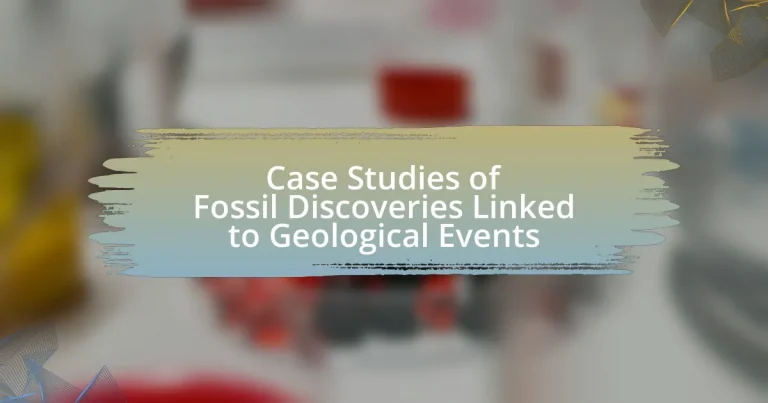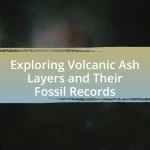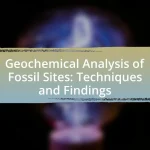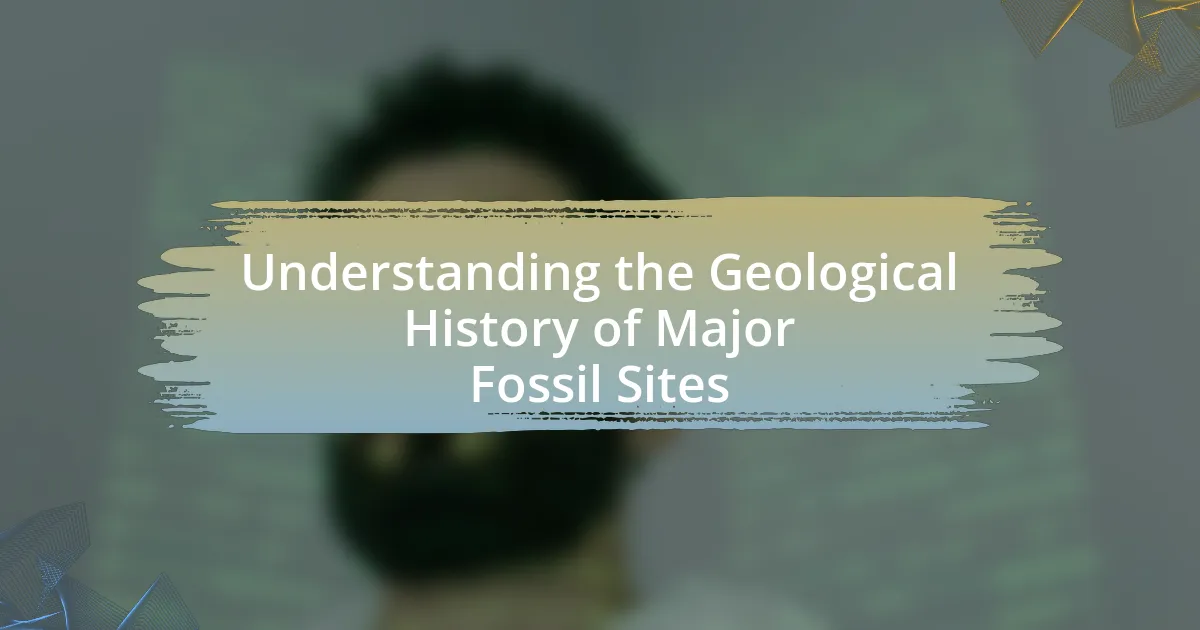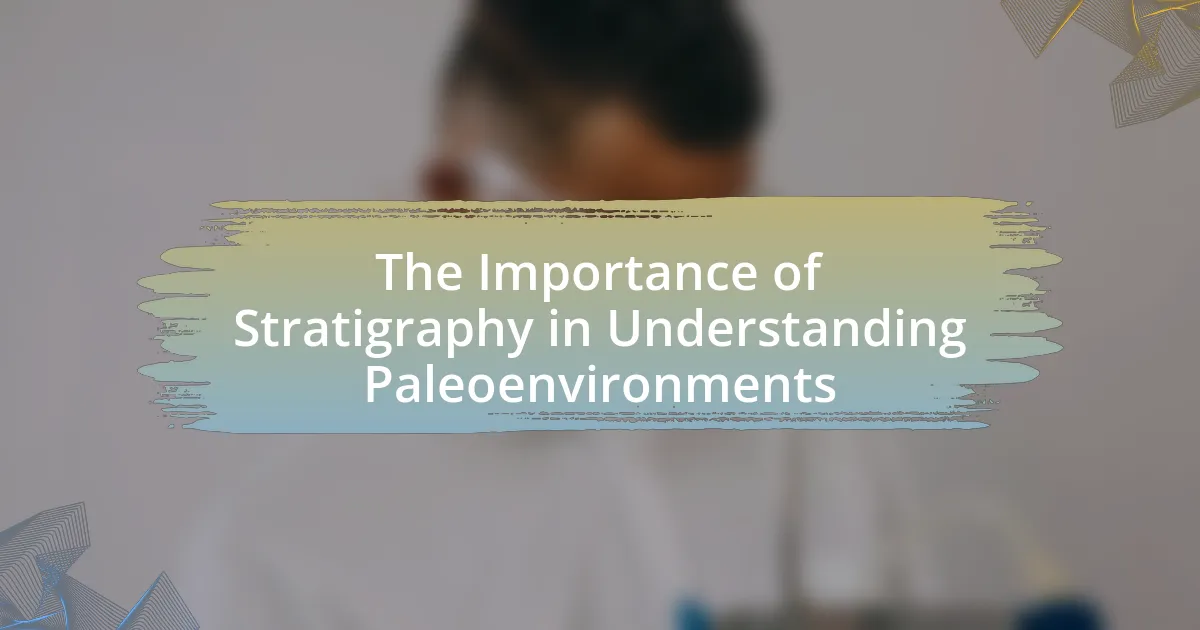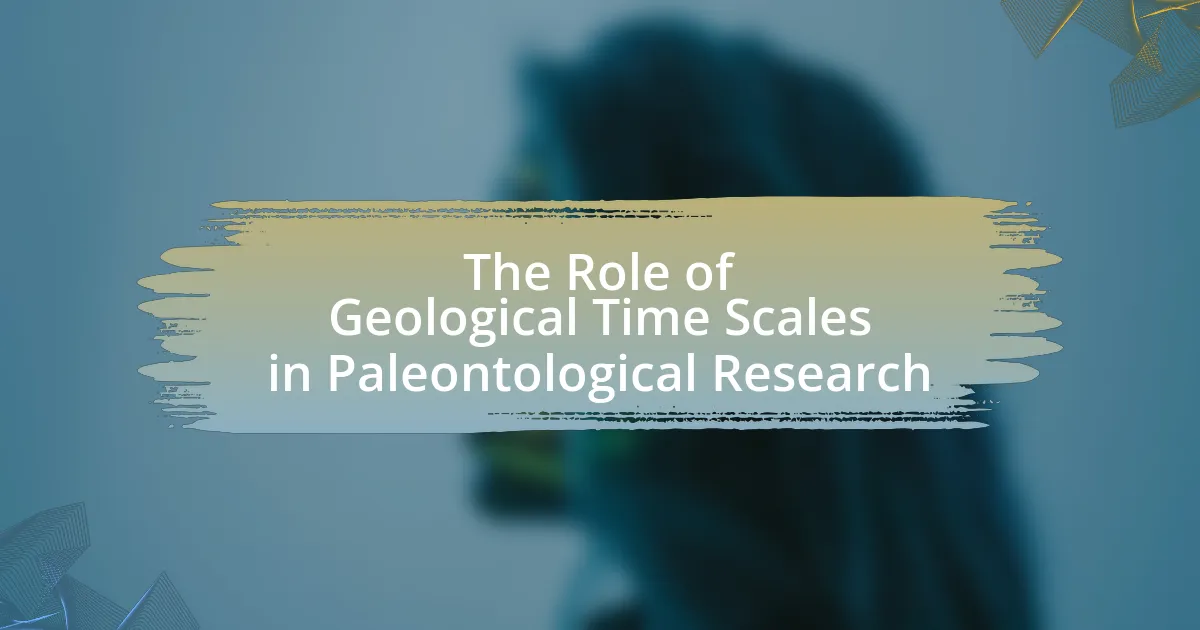The article focuses on case studies of fossil discoveries that are directly linked to geological events, highlighting significant sites such as the Burgess Shale in Canada, the La Brea Tar Pits in California, and the Chicxulub crater in Mexico. It explores how geological events like volcanic eruptions, sedimentation, and asteroid impacts influence fossil preservation and provide insights into past ecosystems and evolutionary processes. The article emphasizes the importance of these case studies in understanding the relationship between geological changes and biodiversity, as well as their implications for modern science, including climate change research and biodiversity conservation efforts.
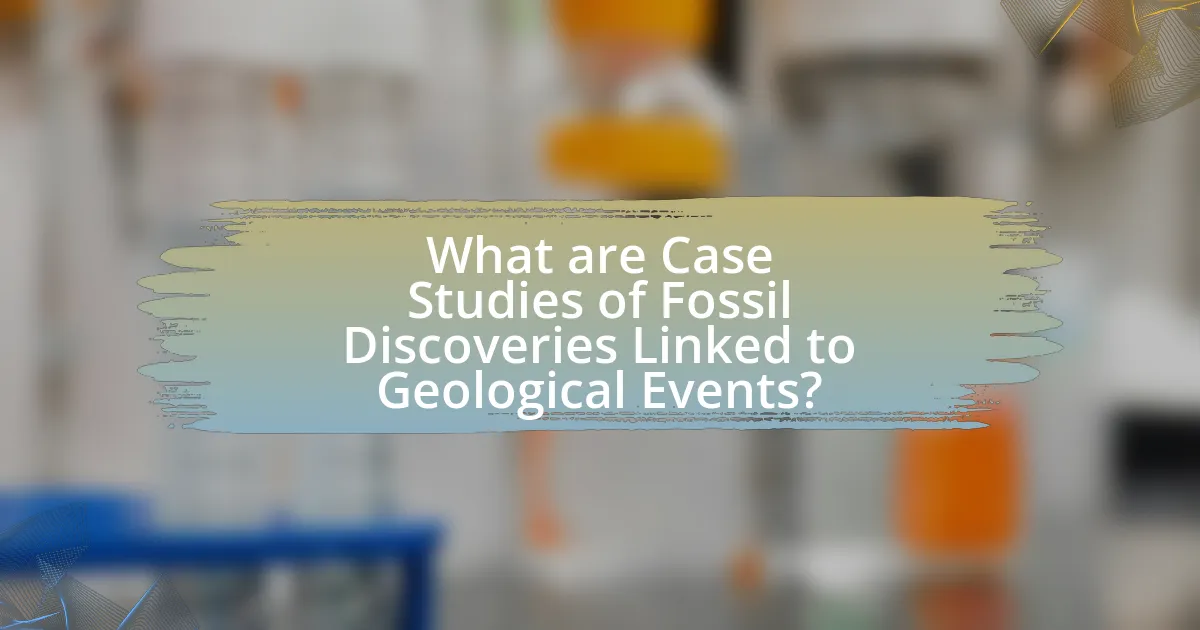
What are Case Studies of Fossil Discoveries Linked to Geological Events?
Case studies of fossil discoveries linked to geological events include the Burgess Shale in Canada, which showcases a diverse array of Cambrian fossils resulting from a significant underwater landslide. This event preserved soft-bodied organisms that provide insight into early marine life. Another example is the La Brea Tar Pits in California, where fossils from the Pleistocene epoch were trapped in asphalt, revealing a rich ecosystem influenced by climatic changes and geological activity. Additionally, the Chicxulub crater in Mexico, formed by an asteroid impact, is associated with the mass extinction event that wiped out the dinosaurs, leading to the discovery of fossils that illustrate the aftermath of this geological catastrophe. These case studies demonstrate the direct relationship between geological events and the preservation of fossil records, offering critical insights into Earth’s biological history.
How do fossil discoveries relate to geological events?
Fossil discoveries are directly related to geological events as they provide evidence of past life forms and their environments during specific geological periods. For instance, the fossil record reveals how mass extinction events, such as the Cretaceous-Paleogene extinction approximately 66 million years ago, corresponded with significant geological changes like asteroid impacts and volcanic activity. These events led to drastic shifts in climate and habitat, which are reflected in the fossilized remains of species that either thrived or perished as a result. The correlation between fossil findings and geological strata allows scientists to reconstruct Earth’s history, demonstrating how life has adapted or been wiped out in response to geological transformations.
What types of geological events are commonly linked to fossil discoveries?
Geological events commonly linked to fossil discoveries include volcanic eruptions, sedimentation processes, and tectonic activities. Volcanic eruptions can rapidly bury organisms in ash, preserving them as fossils, as seen in the fossilized remains found in the La Brea Tar Pits, which were formed by natural asphalt seepage. Sedimentation processes, such as river deltas or ocean floor deposits, create conditions for fossilization by covering organic material with layers of sediment, exemplified by the fossil-rich formations in the Hell Creek Formation, which document the late Cretaceous period. Tectonic activities, including earthquakes and continental drift, can expose previously buried fossils, as observed in the uplift of the Himalayas, where ancient marine fossils have been discovered in high-altitude regions.
How do these geological events influence fossil preservation?
Geological events significantly influence fossil preservation by determining the conditions under which organisms are buried and the subsequent processes that affect their remains. For instance, rapid sedimentation during events like volcanic eruptions or landslides can quickly cover organic material, reducing exposure to oxygen and scavengers, which enhances preservation. Additionally, specific geological settings, such as anoxic environments found in deep-sea sediments, can lead to exceptional fossil preservation by preventing decay and promoting the formation of fossils through processes like mineralization. Evidence of this can be seen in the fossil record, where fossils from the Burgess Shale, formed during a marine transgression, exhibit remarkable detail due to the rapid burial and low-oxygen conditions that prevailed at the time.
Why are case studies important in understanding fossil discoveries?
Case studies are important in understanding fossil discoveries because they provide detailed, contextual insights into the conditions and processes that led to the preservation of fossils. By examining specific fossil sites, researchers can analyze the geological, environmental, and biological factors that influenced fossilization, which enhances our comprehension of past ecosystems. For instance, the Burgess Shale in Canada offers a case study that reveals the diversity of Cambrian life and the unique sedimentary conditions that contributed to the exceptional preservation of soft-bodied organisms. Such case studies not only illustrate the complexity of ancient life but also inform broader paleontological theories and models, making them essential for advancing our knowledge of evolutionary history.
What insights can case studies provide about past ecosystems?
Case studies provide critical insights into past ecosystems by revealing the interactions between organisms and their environments during specific geological events. For instance, the examination of fossilized remains from the Permian-Triassic extinction event illustrates how drastic climate changes led to the loss of biodiversity and the restructuring of ecological communities. Research published in “Nature” by Erwin et al. (2011) highlights that these case studies allow scientists to reconstruct ancient habitats, understand species adaptations, and assess the resilience of ecosystems to environmental stressors. Such detailed analyses contribute to a comprehensive understanding of how past ecosystems functioned and evolved in response to significant geological changes.
How do case studies contribute to our knowledge of evolutionary processes?
Case studies contribute to our knowledge of evolutionary processes by providing detailed, real-world examples of how species adapt and change in response to environmental pressures. For instance, the fossil record from the Burgess Shale in Canada reveals a diverse array of Cambrian organisms, illustrating the rapid evolution of complex life forms during that period. This specific case study highlights how geological events, such as mass extinctions and continental drift, can drive evolutionary change by altering habitats and creating new ecological niches. Such concrete examples allow scientists to observe patterns of evolution, test hypotheses, and refine theories about the mechanisms driving biodiversity over time.
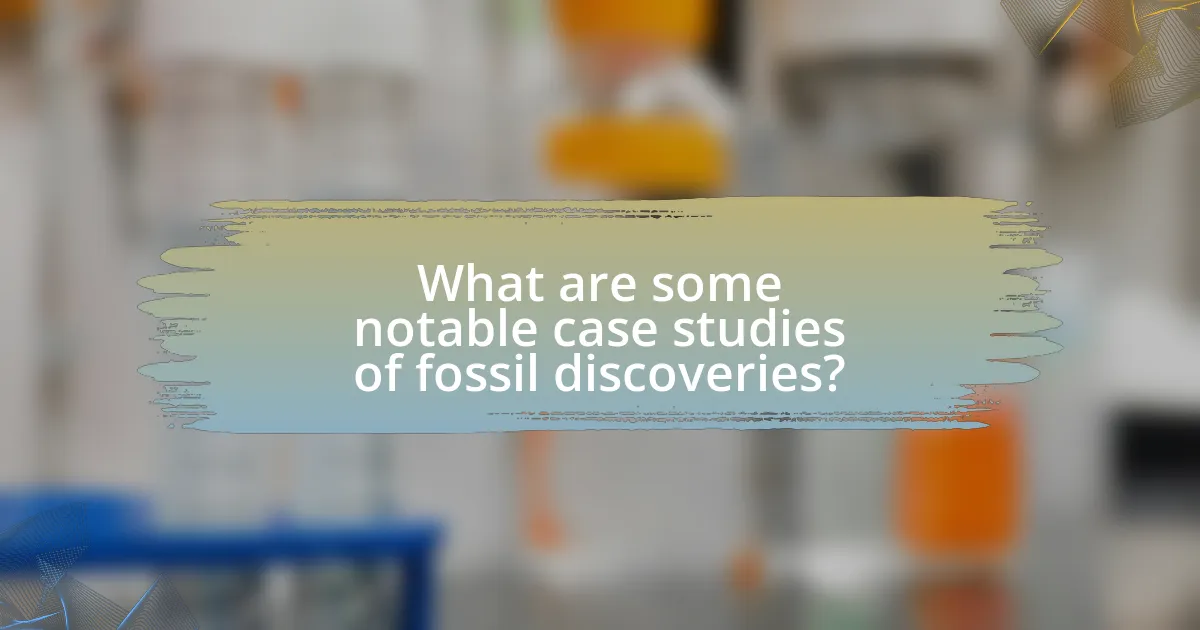
What are some notable case studies of fossil discoveries?
Notable case studies of fossil discoveries include the Burgess Shale in Canada, which revealed a diverse array of Cambrian organisms, showcasing early complex life forms. Another significant case is the La Brea Tar Pits in California, where well-preserved fossils of Ice Age mammals, such as saber-toothed cats and woolly mammoths, provide insights into prehistoric ecosystems. The discovery of the fossilized remains of dinosaurs in the Gobi Desert, particularly the Velociraptor, has also been crucial in understanding dinosaur behavior and evolution. Each of these sites has contributed valuable information about the history of life on Earth and the geological events that shaped it.
How did the Chicxulub impact event affect fossil records?
The Chicxulub impact event led to a significant disruption in fossil records, particularly marking the boundary between the Cretaceous and Paleogene periods. This event caused mass extinctions, eliminating approximately 75% of Earth’s species, including the non-avian dinosaurs. The abrupt environmental changes, such as wildfires, tsunamis, and a “nuclear winter” effect from debris blocking sunlight, resulted in a sharp decline in biodiversity. Consequently, the fossil record shows a distinct gap in species diversity and abundance immediately following the impact, with a sudden appearance of new species in the subsequent Paleogene period. This pattern is evidenced by the presence of a thin layer of iridium-rich clay found globally, which correlates with the timing of the impact and the subsequent changes in fossil assemblages.
What types of fossils were discovered in relation to the Chicxulub event?
The types of fossils discovered in relation to the Chicxulub event include marine organisms such as ammonites, foraminifera, and bivalves, as well as terrestrial species like dinosaurs and plants. These fossils provide evidence of the mass extinction that occurred approximately 66 million years ago, coinciding with the impact of the Chicxulub asteroid. Studies have shown that the fossil record from this period indicates a significant decline in biodiversity, particularly among species that were unable to adapt to the drastic environmental changes caused by the impact.
How did this event shape the biodiversity of the time?
The event significantly shaped the biodiversity of the time by causing mass extinctions and subsequent adaptive radiations. For instance, the Permian-Triassic extinction event, which occurred approximately 252 million years ago, eliminated about 90% of marine species and 70% of terrestrial vertebrates. This drastic reduction in species diversity created ecological niches that allowed for the rapid evolution and diversification of surviving groups, such as the ancestors of modern mammals and dinosaurs. The fossil record indicates that after this event, there was a notable increase in the variety of species, demonstrating how catastrophic events can lead to new evolutionary pathways and increased biodiversity in the aftermath.
What can we learn from the La Brea Tar Pits case study?
The La Brea Tar Pits case study teaches us about the preservation of fossils and the ecological dynamics of prehistoric environments. The site has yielded over 3.5 million fossils, including those of extinct species like the saber-toothed cat and the woolly mammoth, providing insights into the biodiversity and climate of the Pleistocene epoch. The tar pits acted as natural traps, allowing for the exceptional preservation of organic material, which helps scientists understand species interactions and extinction events. This case study highlights the importance of geological processes in fossilization and the role of environmental factors in shaping ancient ecosystems.
What types of fossils have been found at the La Brea Tar Pits?
The La Brea Tar Pits have yielded a diverse array of fossils, including those of large mammals such as saber-toothed cats, mammoths, and dire wolves. These fossils date back to the Pleistocene epoch, approximately 10,000 to 40,000 years ago. The tar pits acted as natural traps, preserving the remains of over 600 species, which provides significant insight into the prehistoric ecosystem of North America.
How do the conditions at the tar pits contribute to fossil preservation?
The conditions at the tar pits contribute to fossil preservation by creating an anaerobic environment that inhibits decomposition. The thick, sticky tar traps and encases organic materials, preventing exposure to oxygen and scavengers, which are primary factors in decay. Additionally, the tar’s chemical composition helps to mineralize the remains over time, further enhancing preservation. This unique combination of factors has led to the discovery of well-preserved fossils, such as those found at La Brea Tar Pits, where thousands of specimens have been excavated, providing valuable insights into prehistoric life.
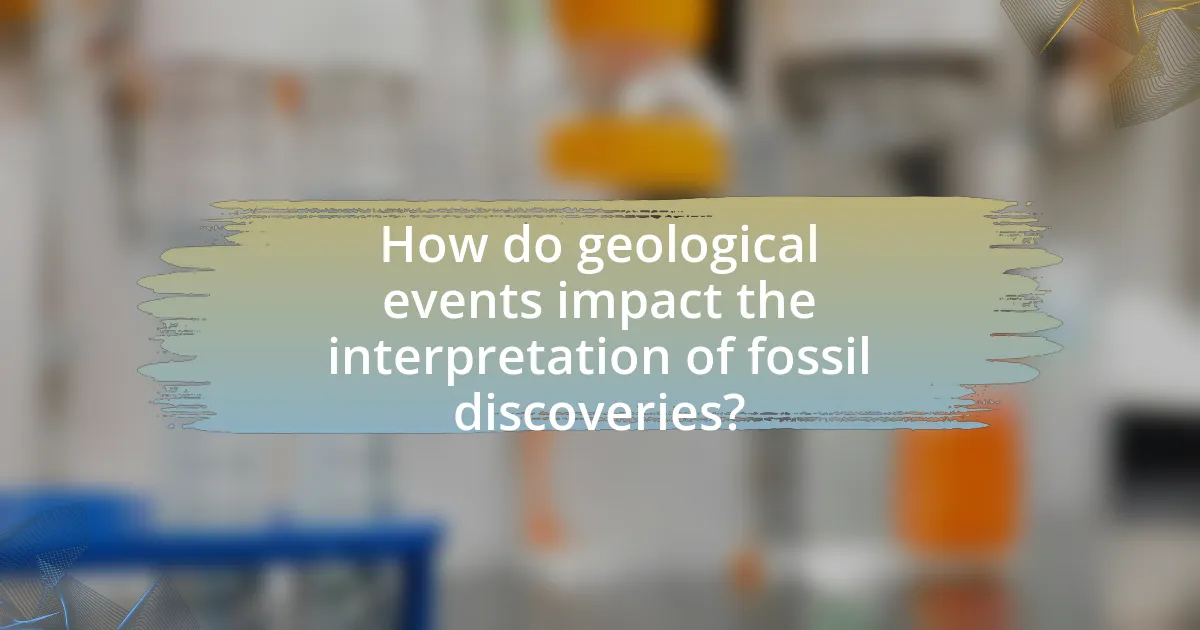
How do geological events impact the interpretation of fossil discoveries?
Geological events significantly impact the interpretation of fossil discoveries by influencing the preservation, distribution, and context of fossils within sedimentary layers. For instance, volcanic eruptions can bury organisms rapidly, leading to exceptional fossilization conditions, while tectonic activity can alter the landscape, causing fossils to be uplifted or displaced. The context in which fossils are found, including their stratigraphic position and associated sedimentary features, provides critical information about the environment and time period in which the organisms lived. For example, the discovery of marine fossils in what is now a mountainous region indicates past geological events, such as plate tectonics, that reshaped the Earth’s surface. Thus, understanding geological events is essential for accurately reconstructing ancient ecosystems and evolutionary histories.
What role do geological timelines play in understanding fossil records?
Geological timelines are essential for understanding fossil records as they provide a chronological framework that allows scientists to date fossils and correlate them with specific geological events. By establishing the age of rock layers through methods such as radiometric dating, researchers can determine when particular organisms existed and how they evolved over time. For instance, the fossil record of dinosaurs is placed within the Mesozoic Era, which spans from approximately 252 to 66 million years ago, allowing paleontologists to study their development and extinction in relation to significant geological changes, such as the mass extinction event at the end of the Cretaceous period. This correlation between geological timelines and fossil records enables a clearer understanding of the history of life on Earth and the environmental conditions that influenced evolutionary processes.
How can dating methods enhance our understanding of fossil discoveries?
Dating methods enhance our understanding of fossil discoveries by providing precise timelines for when organisms lived and died. Techniques such as radiometric dating allow scientists to determine the age of fossils by measuring the decay of isotopes, which can reveal the geological period in which the fossils were formed. For instance, carbon dating can date organic materials up to about 50,000 years old, while uranium-lead dating can date much older fossils, sometimes exceeding millions of years. This chronological context is crucial for reconstructing evolutionary lineages and understanding the environmental conditions that influenced the organisms’ development and extinction. By establishing a timeline, researchers can correlate fossil findings with geological events, such as mass extinctions or climate changes, thereby enhancing our comprehension of the Earth’s biological history.
What challenges arise when correlating fossils with geological events?
Correlating fossils with geological events presents several challenges, primarily due to the complexities of dating methods and the incomplete fossil record. Dating methods, such as radiometric dating, can yield varying results based on the geological context, leading to discrepancies in the timing of events. Additionally, the fossil record is often fragmented, with gaps that make it difficult to establish a continuous timeline of life and environmental changes. For instance, the Permian-Triassic extinction event, which occurred approximately 252 million years ago, shows uneven fossil representation across different regions, complicating the correlation of specific fossils to the event. These factors contribute to uncertainties in understanding the precise relationships between fossils and geological events.
How can we apply findings from fossil case studies to modern science?
Findings from fossil case studies can be applied to modern science by enhancing our understanding of evolutionary processes and environmental changes. For instance, fossil records provide insights into species adaptation and extinction patterns, which can inform current biodiversity conservation efforts. A notable example is the study of the Permian-Triassic extinction event, where fossil evidence reveals how ecosystems responded to dramatic climate shifts, guiding contemporary climate change models. Additionally, paleobiological data can help predict future biological responses to environmental stressors, as seen in research published in “Nature” by Erwin et al. (2011), which discusses the implications of past mass extinctions on current species resilience.
What implications do these findings have for current biodiversity conservation efforts?
The findings from fossil discoveries linked to geological events imply that current biodiversity conservation efforts must prioritize understanding historical extinction patterns and resilience mechanisms. These discoveries reveal how past environmental changes have led to significant biodiversity loss, indicating that similar future changes could threaten existing species. For instance, studies show that mass extinction events, such as the Permian-Triassic extinction, resulted in the loss of approximately 90% of marine species, highlighting the vulnerability of ecosystems to rapid changes. Therefore, conservation strategies should incorporate lessons from these historical events to enhance the resilience of current ecosystems against climate change and habitat destruction.
How can fossil discoveries inform climate change research?
Fossil discoveries can inform climate change research by providing historical data on past climate conditions and biological responses to those conditions. For instance, the study of fossilized plants and animals reveals how ecosystems adapted to temperature fluctuations and atmospheric changes over millions of years. Research indicates that during the Paleocene-Eocene Thermal Maximum, approximately 56 million years ago, global temperatures rose significantly, leading to the extinction of certain species and the proliferation of others, which helps scientists understand potential future impacts of current climate change. This evidence underscores the relationship between climate shifts and biodiversity, offering critical insights for predicting future ecological responses to ongoing climate change.
What best practices should researchers follow when studying fossil discoveries linked to geological events?
Researchers studying fossil discoveries linked to geological events should prioritize meticulous documentation of the context in which fossils are found. This includes recording the stratigraphic layer, sediment characteristics, and associated geological features, as these details are crucial for understanding the environmental conditions at the time of fossilization. For instance, the discovery of fossils in a volcanic ash layer can indicate a specific geological event, such as a volcanic eruption, which can be correlated with other geological data. Additionally, employing interdisciplinary approaches, such as integrating paleontology with geology and geochemistry, enhances the interpretation of fossil findings. This practice is supported by studies that demonstrate how combining these fields can lead to more comprehensive insights into past ecosystems and their responses to geological changes.
